Method development
Upti-select kit™
The solution for fast and reliable HPLC method development.
Which type of column should I choose?
Our Upti-select Kit™ provides a reliable response, in just two steps, to this question commonly asked by chemical analysis researchers.
- Predicts and determines the optimal column for separation
- Eliminates column selection uncertainty
- Faster optimisation
- Improves project management
- Reduces development costs
The analysis of general, Engelhardt, Lesellier & Tchapla, Sander & Wise, and Tanaka tests, together with the scientific work we have conducted over the last few years with LETIAM (S. Héron & A. Tchala), have enabled us to create a selection of our Uptisphere® and Uptisphere® Strategy™ stationary phases offering different yet complementary selectivities and the broadest separation potential possible.
Selected phases:
| Phase | Pore size | Surface area | Bonding | Functionalisation | % C | End-capping | pH stability | |
| Strategy™ | C18-3 | 100 Å | 425 m2/g | C18 - Octadecyl | monofunctional | 22% | Multi step | 1 - 12 |
| Strategy™ | C18-2 | 100 Å | 425 m2/g | C18 - Octadecyl | monofunctional | 19% | Multi step | 1 - 10 |
| Strategy™ | PRO | 100 Å | 425 m2/g | C12 - Dodecyl | monofunctional | 16% | One step | 1.5 - 8 |
| Strategy™ | RPX | 100 Å | 425 m2/g | Proprietary | monofunctional | UC | UC | 1.5 - 7 |
| Uptisphere® | HSC | UC | UC | C18 - Octadecyl | monofunctional | 20% | Multi step | 1.5 - 8 |
| Uptisphere® | ODB | 120 Å | 320 m2/g | C18 - Octadecyl | monofunctional | 18% | One step | 1.5 - 7 |
| Uptisphere® | HDO | 120 Å | 320 m2/g | C18 - Octadecyl | monofunctional | 17% | Mixed | 1.5 - 7 |
| Uptisphere® | NEC | 120 Å | 320 m2/g | C18 - Octadecyl | monofunctional | 16% | Non-EC | 1.5 - 6.5 |
| Uptisphere® | TF | UC | UC | C18 - Octadecyl | polyfunctional | 14% | One step | 1.5 - 8 |
| Uptisphere® | MM1 | 120 Å | 320 m2/g | C8/SCX | monofunctional | UC | UC | 2 - 6.5 |
Standard applications
| Phase | Application | |||
| Strategy™ | C18-3 | The high bonding density of C18-3 facilitates the separation of highly non-polar compounds. Its stability is guaranteed to up to pH 12 by multi-step end capping, making it an excellent choice for the analysis of basic compounds. | ||
| Strategy™ | C18-2 | C18-2 is the phase of choice for most pharmaceutical applications. Its surface area of 425 m2/g allows high loading capacities. | ||
| Strategy™ | PRO | For separation of non-polar compounds. Although less retentive than C18, its loading capacity is higher. | ||
| Strategy™ | RPX | Perfect for moderately polar and non-polar compounds. Offers excellent stability under 100% aqueous conditions. | ||
| Uptisphere® | HSC | High retention of non-polar compounds. | ||
| Uptisphere® | ODB | The phase of choice for reversed-phase separation of non-polar compounds. | ||
| Uptisphere® | HDO | Perfect for moderately polar and non-polar compounds. Offers excellent stability under 100% aqueous conditions. | ||
| Uptisphere® | NEC | This non-EC phase yields amazingly perfect peak symmetries with basic products. | ||
| Uptisphere® | TF | TF offers distinctive selectivity that is worth trying with difficult separations for aromatics, polyphenols, PAHs and other such products. | ||
| Uptisphere® | MM1 | Good separation of moderately polar organic compounds in their cationic form. |
Develop your HPLC method in just two steps
Step 1:
Inject the analysis sample and a proprietary reference mixture (RM) into the filled Uptisphere® or Strategy™ C18-2 column in order to:
- Determine the retention time of a reference peak (RP) from the analysis sample and the retention times of the compounds of the reference mixture (RM), and then calibrate the calculation system.
Choose a retention factor for the reference peak (RP): K´RP.
Enter it into the spreadsheet (supplied) along with the retention times of the reference mixture (RM) compounds.
This portion of the step allows you to determine, for each of the columns in the kit you have assembled:
- The percentages of methanol and acetonitrile to be added to each mobile phase to obtain the retention factor K´RP chosen for the reference peak (PR).
Step 2:
Prepare the mobile phases according to the results of step 1. Inject the analysis sample into each of the kit´s columns (for verification purposes, the sample can also be reinjected in the ODB or C18-2 column).
Analyse the chromatograms to select the best column for the desired separation.
Proceed to the column optimisation step.
The Upti-select Kit™ consists of various components:
a) An Uptisphere® ODB or Strategy™ C18-2 reference column
b) Your selection of one or more selectivities from the list of columns for the Upti-select Kit™.
Other selectivities may be added as dictated by your requirements or budget.
c) A pack of tools containing:
a. A proprietary reference mixture consisting of five probes for calibrating the calculation system
b. A USB flash drive containing the spreadsheet and reference documentation.
The Upti-select Kit™ is available in the following configurations:
| 1 reference column + 1 selectivity | = standard catalogue price |
| 1 reference column + 2 selectivities | = 10% off the standard catalogue price |
| 1 reference column + 3 selectivities | = 15% off the standard catalogue price |
| 1 reference column + 4 selectivities | = 20% off the standard catalogue price |
| 1 reference column + 5 selectivities | = 25% off the standard catalogue price |
| (a discount of 25% off the standard catalogue price is applied to orders for more than five selectivities) | |
To order:
- Indicate code HV8510 (Upti-select column) on your order form.
- Indicate the P/N of the Uptisphere® ODB or Strategy™ C18-2 reference column that you have chosen.
- Indicate the P/N(s) of the complementary selectivity columns that you have chosen.(the reference column and the selectivities selected must have the same dimensions and particle size)
The column P/Ns are listed on pages B14 to B37.
Remember to also order the Upti-select Kit™ tool pack (P/N BB2290).
Transposing the chromatographic conditions of a stationary phase to an Interchim stationary phase
Introduction
If you are dissatisfied with how compounds are separated under your analysis conditions (column, silica, temperature, etc.), you can either:
- improve the selectivity
- or change your column (stationary phase)
In general, the selectivity optimisation requires the use of a specific software program or a method of trial and error.
Whatever the case, no fewer than 18 trials will be necessary for a given pH and temperature. And after all that, there is no guarantee that the desired separation will be achieved. The only thing left to do is start all over with a different stationary phase.
Interchim has specially developed C18 stationary phases that make the entire process simpler.
In just two experiments, and using your own results (compounds and column), our method helps you find the right isocratic conditions for analysis for the 5 µm, 3 µm, 2.2 µm and 1.7 µm stationary phases in our range.
LETIAM (S. Héron & A. Tchapla) has determined the thermodynamic parameters that characterise each of our stationary phases for methanol/water or acetonitrile/water eluents. This work is based on fundamental research articles published by L.R. Snyder, P. J. Schoenmakers and P. Jandera.
Two parameters are used as measurements:
- the hydrophobic character of the silica particles
- their polarity in a hydro-organic medium
Each of our C18 stationary phases offers a different separation potential that is defined by these parameters, thereby allowing you to choose the silica that best matches your analysis criteria (total separation, elution order, analysis time, etc.).
The process
Step 1:
Determine the peak that to be used as the reference (RP, generally the most retained) by injecting your compounds into your column. Determine the retention times of our reference compounds (RM) by injecting this mixture into your column under your analytical conditions.
Enter this data in the spreadsheet supplied with the Upti-select Kit™ pack or available at www.interchim.com. You have now defined, for the ten Interchim 5 µm stationary phases (C18-2, C18-3, PRO, RPX, MM1, ODB, HDO, HSC, NEC and TF), the organic solvent percentages (methanol or acetonitrile) that will make it possible to obtain a retention factor that is very close to that chosen for the reference peak (use a maximum value of close to 15).
Step 2:
After injecting your sample into the ten columns with the mobile phases from step 1, select the optimal column.
Example of transposition with a sample of solar filters
| Step 1: a) sample of anti-UV agents consisting of the following products: A: 2-Ethylhexyl-2-Cyano-3,3-Diphenylacrylate B: 2-Ethylhexyl-3-[4-Methoxyphenyl]-2-propenoate C: 4-t-Butyl-4´-methoxy-dibenzoyl-methane D: 2-Ethylhexyl Salicylate is injected into an Akzo Nobel Kromasil* 100-5C18, 250 × 4.6 mm column under the following conditions: MeCN-H2O (70/30) - 1 ml/min. - 25°C - UV: 238 nm Peaks A and B are co-eluted and the analysis time is greater than 50 min. Peak D is chosen as the reference peak. b) the reference mixture (RM) is injected into the same column under the same conditions. The retention times of the reference peak D and the compounds in the mixture (RM) are entered in the Interchim spreadsheet. The retention factor of the reference peak D is set at 10. The percentage values of organic solvent (methanol or acetonitrile) to be set to obtain the retention factor kD chosen for the reference peak D are yielded by our spreadsheet. |
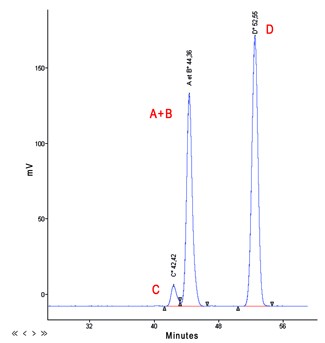 |
| Step 2: The methanol or acetonitrile mobile phases are prepared according to the results of step 1. The analysis sample is injected into the ten columns according to the conditions set by the spreadsheet in order to obtain a retention factor set at 10 for the reference peak D. Two mixtures of anti-UV agents of different quantitative composition were used for this test. This explains why the peak surface areas ratios are not always maintained when the chromatograms of certain stationary phases are compared with those of others. The identification was obtained following the injection of undiluted standards. Solute C is a chelating agent that gives distorted or very broad peaks with some stationary phases. |
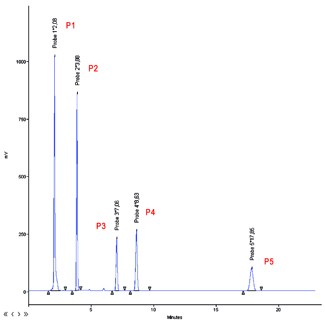 |
Chromatograms obtained with acetonitrile/water as the mobile phase
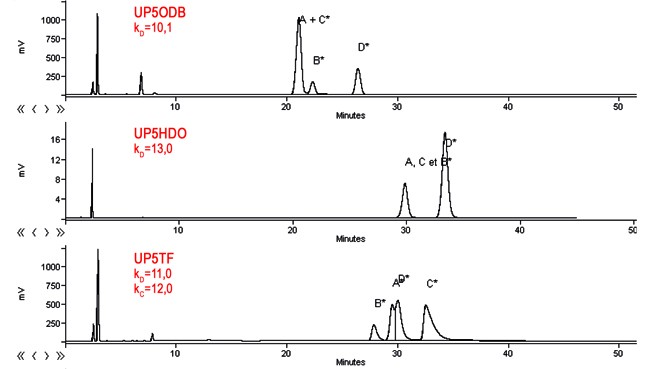
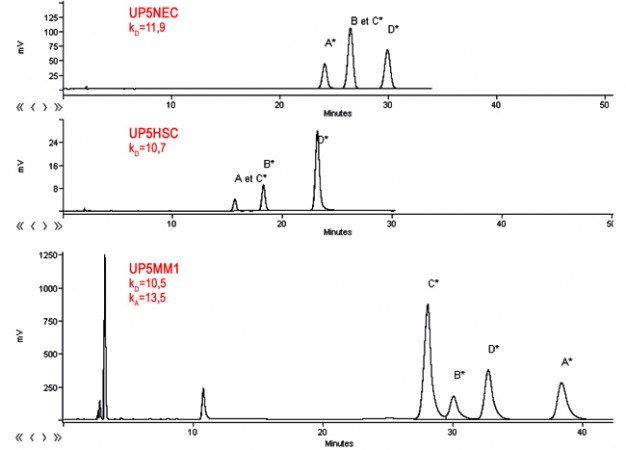
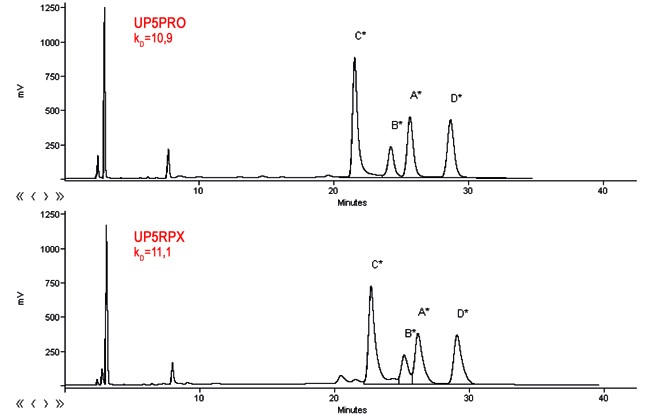
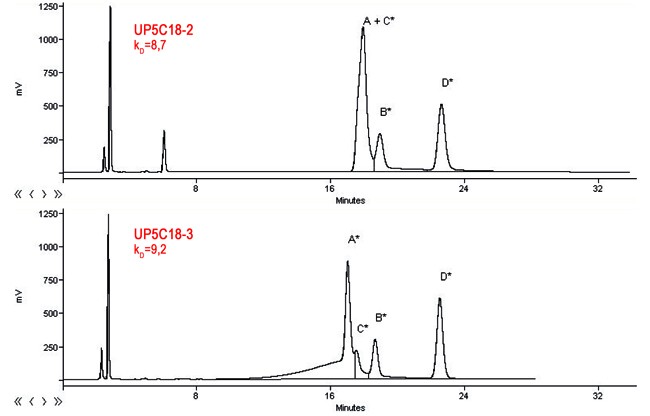
Observations:
The chromatograms show that the retention factor of the reference peak on the ten Uptisphere® columns is close to 10. This result confirms the process whereby the theoretical transposition equations are used from one stationary phase to another.
Coelution of some peaks occurred on some stationary phases.
The separation of the four compounds was achieved on the Uptisphere® MM1, PRO and RPX columns, with reversals of the elution order of the peaks.
Depending on the surface chemistry of our phases, compound D was not always the last peak. The last peak remained in a range of retention close to a retention factor of 10.
Chromatograms obtained with methanol/water as the mobile phase
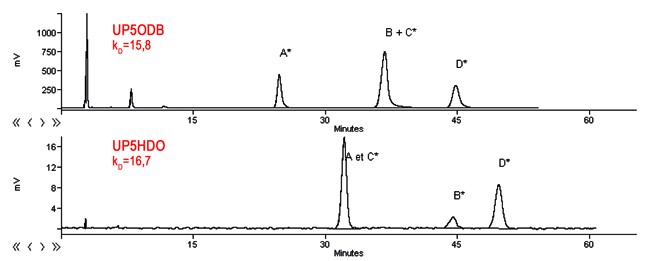
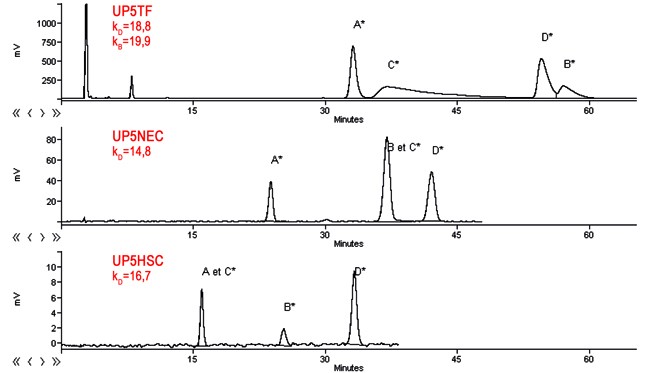
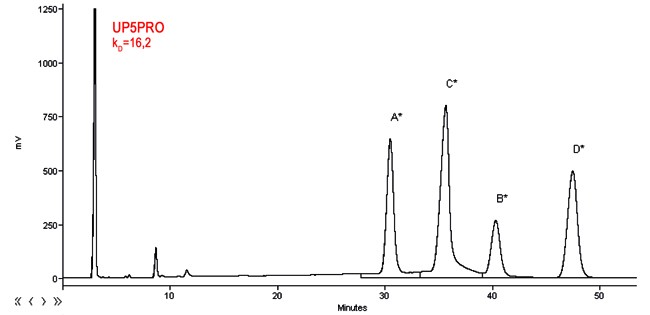
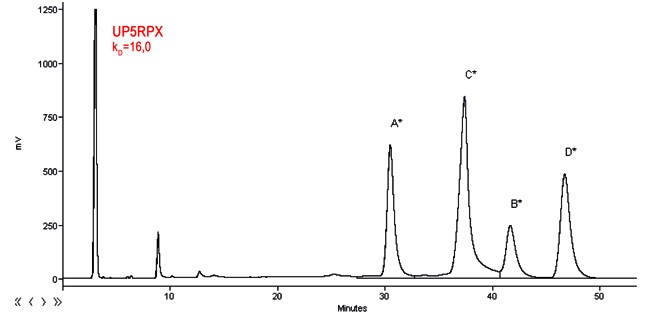
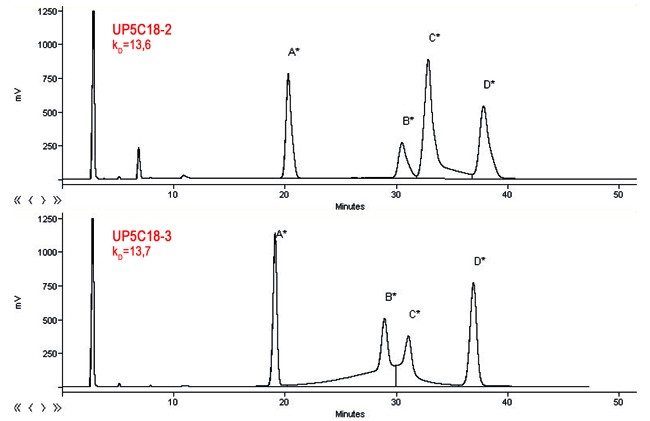
Observations:
Just as with the MeCN/H2O mixtures, the retention factors of reference peak D on the ten Uptisphere® columns were close to 15. This result again confirms the process whereby the theoretical transposition equations are used from one stationary phase to another.
Coelution of some peaks occurred on some stationary phases.
The separation of the four compounds was achieved on the Uptisphere® TF, PRO, RPX and C18-2 columns, with reversals of the peak elution order and a highly variable peak shape for compound C.
The various profiles obtained with methanol and acetonitrile allow you to choose the stationary phase that appears to be most optimal for your needs: analysis time, resolution of critical pairs, etc.